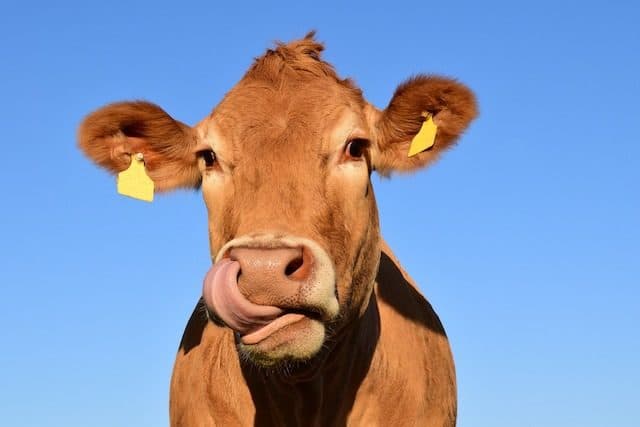Everything comes from somewhere. This statement is so absurdly obvious that it is rarely worth making. And yet its implications are rarely explored. Where are you from? Finding the exact time and place where humans emerged is not easy, and the same is true for most forms of life. But there are some things we can trace with a fair degree of precision, often with surprising results.
10. Modern cattle can be traced back to a single herd about 11,000 years ago.

The average American eats 55 pounds of beef per year, so cow meat is very much loved here. Our ancient ancestors never had this pleasure, because although there were once herds of animals such as aurochs, modern cows as we know them never existed in the wild. In fact, we can trace our current global cattle family back to a herd of 81 female animals , which was bred almost 11,000 years ago.
Researchers from across Europe are analysing DNA samples from living cattle, as well as DNA from extracted from the bones, taken from archaeological sites that date back to the beginning of agriculture as we know it. The genetic differences seen in modern cattle could only exist if the original herd was limited to about 80 animals, descended from the ancient aurochs, which were somewhat similar to the modern cow, but not quite the same, and certainly much larger and wilder.
9. All domesticated hamsters trace back to a single pair in Syria

Much attention has been paid to the domestication of both cats and dogs, the two most common pets in the world. Most of us know that dogs were domesticated from wolves long ago, and cats seem to have domesticated themselves along with humans in an almost strategic move to provide food and shelter. But people keep many other animals as pets, such as hamsters.
Wild hamsters are probably not something most of us have ever encountered, but they do exist, and the modern domesticated hamster can be traced back to a specific breeding pair in Syria. Their history is both curious and remarkable.
Jewish biologist Israel Aharoni set out to identify the animals listed in the Torah. The problem was that the animals had no names, only very vague descriptions. And one animal he was particularly interested in had a name that translates into English as " Mr. Saddlebags "The only description of it was that it was golden. Not much to go on.
In 1930, Aaron went to Syria and hired a hunter. They traveled the countryside looking for clues, and then dug a hole on a farm and found a nest of small golden animals. He found hamsters. Mr. Saddlebags.
Aharoni took the hamsters, and the situation quickly got out of hand. The mother ate several of the babies. Several more escaped and were never found. But one pair of siblings reproduced, as hamsters tend to do. They became the Adam and Eve of the modern hamster world. This pair had 150 children They were taken to laboratories around the world and continued to breed. Today, if you see a hamster in a pet store anywhere in the world, it will almost certainly be a descendant of this breeding pair.
8. White mushrooms can be traced back to a Pennsylvania farm in 1925.

If you go to the grocery store looking for mushrooms right now, you’ll probably have a few options, depending on how diverse your store is. But if they sell fresh mushrooms at all, they’ll be the porcini mushrooms, sometimes called table mushrooms or button mushrooms. They’re probably the most common type in the Western world, and they can all be traced back to one Pennsylvania farm in 1925.
Before 1925, mushrooms were mostly brown. Your local grocery store today may sell brown button mushrooms next to white button mushrooms, and they look the same except for the color. That's because they are mostly.
Louis Ferdinand Lambert was growing brown mushrooms at Keystone Mushroom Farm when he discovered a white mushroom in the mix. It was a mutation, just a fluke. But he was a budding mushroom researcher, so he took it back to his lab and cultured the spores.
The porcini mushrooms grew faster and were more uniform in shape and size. By 1933 It was the leading mushroom crop in the country, and soon tens of millions of pounds were being produced each year. Buyers were more attracted by the colour and shape, and today it is the most popular mushroom, all thanks to one little mutant in 1925.
7. Australia's 200 million rabbits descended from a handful in the 1800s.

Australia is home to a population of wild rabbits estimated at around 200 million individuals . Is that a lot of rabbits for a country the size of Australia? Definitely, considering it shouldn't be there. Rabbits, as one of many invasive species causing problems down there, were never meant to be there. All those $200 million came from a handful released in 1859.
Although the animals were on the continent as early as 1788, it is believed that 13 or 24 of them were released in 1859 from the farm of homesteader Thomas Austin. He allowed the animals to run around his yard and may have released them to hunt. Apparently, he did not manage to hunt them all.
Australians have been fighting a losing battle with rabbits ever since. In the late 1800s, they were killing two million a year and achieving nothing. The most famous of these is that they tried to build rabbit proof fence across the country, which is effective against larger animals, but did not work against rabbits. They were already on the other side of the fence before construction was completed.
6. Golden Retrievers are descended from two dogs named Nose and Belle.

According to the American Kennel Club, the golden retriever was third most popular dog breed in America in 2021. In fact, it consistently ranks in the top 10 breeds. They are sweet and a little silly, and seem to make good family dogs. The entire breed can also be traced back to two specific dogs named Nose and Belle in 1868.
A Scotsman named Sir Dudley Courts Marjoribanks owned the first example of the breed, a dog named Nous, who was said to be a kind of yellow retriever. The original story was that Nous was a Russian circus dog, but there is no evidence that this is true. The real story seems to be that he was just out for a walk one day, saw the dog and bought it from a shoemaker .
Sir Dudley, as a breeder, led detailed breeding logs Records are still available that show he bred the dog with another dog named Belle, a Tweed Water Spaniel, in 1868, and they had a litter of four puppies. The resulting retriever-water spaniel mix developed into a sporty, light-coated dog that clearly struck a chord with people.
5. South Dakota's mountain goats are descended from six escaped Canadian goats.

Mountain goats, more commonly known as Rocky Mountain Goats, can be found in Western Canada and the United States. Their population is estimated to be between 75,000 to 100,000 people . All of those found in the Black Hills can be traced back to six goats from Canada. They were donated to Custer State Park back in 1924, but goats are goats; they weren't content to stay in their pens.
Six goats escaped and went into the wild, where they settled in the granite mountains. Today this number exceeded 200 , and there are no signs of slowing down anytime soon.
4. Most macadamia trees can be traced back to one Australian tree.

Hawaii is famous for many things, from beautiful beaches to luaus. Macadamia nuts are also huge in the state: in 2019 was produced 40 million pounds sterling. Although the majority of the world's macadamia nuts come from Australia and South Africa , their origins are not so diverse. Seventy percent All the world's macadamia nuts come from a single tree in Australia.
Plant biodiversity is important. The lack of diversity in bananas has led to an entire variety of bananas going extinct, so the area is of great interest to scientists. In an attempt to trace the origins of macadamia trees, they tested samples from farmed trees in Hawaii and wild ones in Australia and found that they were all related to a very small population on a private island called Molu. The genetic differences between the trees were so small that they believe they all likely came from the same individual tree.
3. Most purebreds can be traced back to the Darley Arabian.

When a horse proves himself on the track, he is often retired as a stud horse, where breeders try to continue and improve his genetic line. No horse seems to have done this better than the Darley Arabian.
There are 500,000 Thoroughbred horses in the world. Thoroughbred, which is sometimes used as a synonym for "purebred," is more accurately a distinctive breed of racehorse. They are generally considered the best racehorses in the world, and nearly all of the half million can trace their ancestry to 28 specific horses. And among them 95% all males can be attributed to one specific stallion - Darley Arabian.
They say that Thomas Darley bought or possibly stole the foal from a sheikh in Syria. The horse's name was Manak or Manika. Many famous horses were bred by Arabs back in England, and the horse is said to have lived to be 30 years old, a fairly old age for a horse.
2. Almost 150,000 Faroe Islanders are descended from one guy

The Faroe Islands are located in the North Atlantic Ocean near Iceland. Around 158,000 people live or have lived there, and a staggering149,000 of them can trace their lineage back to the same person. Family reunions should be epic.
The prolific ancestor of most Faroese is known as Klemen Laugesen Vollerup. Back in the 17th century, he had 23 children. This turned into 66 grandchildren in 27 villages.
As early as 2006, the island's residents were registered in the so-called genetic biobank , a sort of national registry of Faroese genetics. The computer program kept reading errors because everyone it registered turned out to be a cousin of everyone else.
1. Blue-eyed people can be traced back to one ancestor

Blue eyes are the second most common eye color in the world, although they only exist at 10% people. The color itself is a genetic mutation, and scientists have traced it back to a single common ancestor who lived between 6,000 and 10,000 years ago. Back then, there were only brown-eyed people. The mutation in a certain gene , which is responsible for eye color, occurred in one person and was passed down through generations of 10% blue-eyed people who exist today.
The gene mutation worked in such a way that turned off the allele for brown eyes in the affected person and their ancestors. Essentially, the variant for brown eyes has been removed because the body's ability to produce melanin is reduced by the mutation. This means that brown eyes cannot fully form, and you get blue eyes instead. There is no genetic advantage to the mutation, but there is no disadvantage either, and it seems to be one of those random things that happens in nature.













Оставить Комментарий